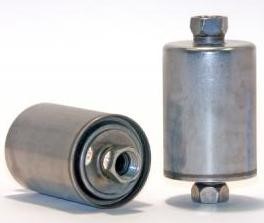Fuel filters are used to strain contaminates from the fuel before it reaches the fuel pump and fuel injectors.
Keeping the injectors clean is important in order for them to function properly.
On traditional EFI systems there is a pre-filter just before the inlet to the fuel pump. This filter is used to catch the larger contaminates and protect the fuel pump from damage.
Think of it like the filter sock used on the end of an in-tank carbureted fuel pickup. It filters out the large contaminates and protects the pump mechanisms.
A fine filter is not used on the inlet due to its restrictive properties. Electric fuel pumps do not draw in well (suction), so any restrictions and low fuel levels will reduce pumping capability. A 100um filter is adequate for the pump inlet side.
Before the fuel reaches the fuel rail it needs to be filtered again to remove the smaller contaminates.
That job is done by a filter that has a finer filtering media, typically 10um, to catch the smaller contaminates.
A popular OE filter used on late 1990’s GM pickup trucks is shown in Photo 1. It is inexpensive, very effective, and available at just about every auto parts store in the USA.

Photo 1. A late 1990’s GM truck in-line fuel filter.
These filters are built into many modern cars.
Many modern cars, including the new 5th-generation Camaro, Cadillac CTS-V2, etc., have these filters built in. They are located in the fuel module and are non-serviceable, but how often does the filter need changing in modern cars?
Fortunately, the filter media is very large so it lasts quite a long time.
In this arrangement, flushing the fuel line is necessary before final attachment to the engine fuel rail. It also makes for a very clean installation since no external filters need to be mounted on the chassis or in the engine compartment.
NOTE: Many aftermarket fuel filters have a built-in check valve. If one is used in a returnless system it will cause hot start problems. On hot days/hot engines, at key-off heat soak will cause fuel line pressure to go up, often over 200psi. Once key-off line pressure exceeds about 100psi the injectors no longer function. They are locked by the excessive fuel pressure. The key is to use a safety overpressure valve. This valve, typically in the 85psi range, has a high enough pressure so it stays out of the normal operating range, but low enough to allow the fuel injectors to function. VaporWorx has simple to use 85psi regulators available.
Continued Reading
This article is part 5 of the 10-part informational series: Fuel Delivery Systems – An Understanding
To continue reading in the series, use the navigation below:
Or, click here to view the full navigation/table of contents for this series.
Want to know more?
Whether you have a question about the material on this page, want to know more about our products - from purchase to installation to maintenance - or anything else, contact us anytime: we're ready to talk about your ride!
